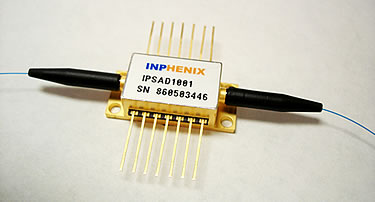
Introduced in the 1990s, the optical amplifier gave new dimensions to the regenerator technology and opened new opportunities to the WDM (Wavelength Division Multiplexing) technology as well. Mainly, it is used for directly amplifying an optical signal without having to convert it into an electrical signal.
As you may already know, there are several kinds of optical amplifiers including erbium-doped-fiber amplifiers (EDFAs), Raman amplifiers, and the popular semiconductor optical amplifiers (SOAs). In this blog, we will discuss semiconductor optical amplifiers in detail and take a look into their advantages and disadvantages. Keep scrolling!
Semiconductor optical amplifiers make use of a semiconductor as a gain medium. These are specially designed to increase the optical launch power in order to compensate for the loss of optical devices in general applications.
SOAs are frequently used in telecommunication systems as fibre-pigtailed components that are capable of generating gains of a maximum of 30 dB and usually operate at signal wavelengths ranging from 0.85 µm to 1.6 µm.
Further, these are available in multiple wavelengths including 1310nm, 1400 nm, 1500nm and 1600 nm. Also, they can be used either with polarization maintaining fiber i/o or single mode i/o.

We have just discussed the basics of semiconductor amplifiers. Let’s now take a detailed look into their pros and cons. Below are the advantages of SOAs to begin with its advantages:
1. Semiconductor optical amplifiers are electrically pumped and are small in size, making them highly efficient.
2. They are less expensive as compared to other types of optical amplifiers like the Erbium-Doped Fiber Amplifier (EDFA). Also, they can be easily used in modulators, semiconductor lasers, etc.
3. SOAs are capable of conducting all types of non-linear operations like cross-phase modulation, cross-gain modulation, four-wave mixing and wavelength conversion.
4. Semiconductor optical amplifiers can be easily run with a low-power laser.
5. They require lower output power as compared to EDFA.
Just like any other thing, SOAs do have a set of drawbacks as follows:
1. The performance of SOAs still can’t match the performance offered by EDFAs.
2. Semiconductor optical amplifiers produce lower gain, higher noise, higher non-linearity, and moderate polarization dependence.
That’s all about the advantages and disadvantages of semiconductor optical amplifiers. To help you a bit more, we have compiled a list of factors that need to be considered at the time of choosing an SOA.
Selecting the right semiconductor optical amplifier is very important. At the time of making the selection, attention must be paid to every parameter that is mentioned in the datasheet of the products.
For those who don’t know, the main factors that are used to characterize an SOA are the gain bandwidth, gain, noise, and saturation output power. Let’s discuss each of these characteristics in brief:
1. Gain: Gain is a characteristic of SOAs by which the input signal is amplified and then computed as the ratio of output power to input power. An important thing to note here is that the higher the gain, the higher the output optical signal.
2. Gain Bandwidth: It refers to the range where the amplification takes place. When selecting an SOA, make sure that the gain bandwidth is high so that it can easily amplify a variety of signal wavelengths.
3. Saturation Output Power: Saturation output power refers to the max output power that can be attained after amplification. After this point, no amplification can be achieved. The SOA must have a higher saturation level so it can have a higher dynamic range and work efficiently in the linear working region.
4. Noise: Noise is simply the unwanted signal that arises within the bandwidth due to physical processing in the SOA. It is usually measured with a parameter called noise figure, which needs to be around 5 dB.
Semiconductor optical amplifiers are not only cost-effective but also act as a high-performance and efficient solution for WDM networks. Due to their excellent features and benefits they provide, they can be easily used in optical networks, in-line amplification, fiber sensing, and general-purpose measurement and test.
However, they also have their downsides. In these optical amplifiers, electron-hole recombination takes place which tends to lower their performance. We have discussed all the points that should be considered while choosing the right semiconductor optical amplifier. We hope it helps!
Inphenix is a laser and light source manufacturer based in the United States that manufactures a variety of products such as O-band optical amplifiers, distributed feedback lasers, broadband light sources, VCSELs, and swept-source lasers. Contact us to find out more about our high-quality products.
